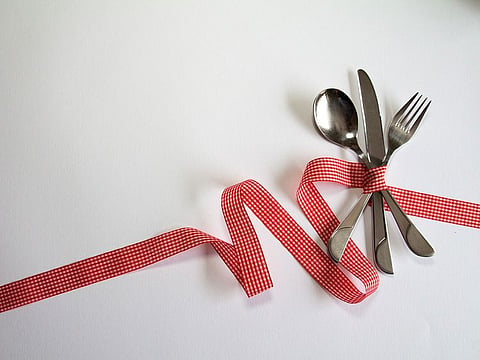The colourful evolution of spoons, forks and knives
The utensils we use today once created controversy and were even ridiculed!

The knife faced off against prehistoric animals, the spoon was used to anoint kings, and the fork created enormous scandals in Europe. Don’t be fooled by the inconspicuous cutlery in your kitchen drawer – it has a long and colourful history.
Of the three, knives came first, for obvious reasons. The earliest knives were made of flint and were used as weapons since prehistoric times. In fact, archaeologists have discovered sharp-edged tools in Ethiopia that are 2.6 million years old.
More precise knife shapes came about in the Bronze Age, where the tool became sharper and slimmer thanks to the malleability of bronze. As metallurgy advanced and technology developed, so did the knife. When iron was discovered in the Iron Age in 1200 BC, the knives we know and use today were born.
But if you’re wondering why the knives we eat with are far less sharp than the ones we cook with, you have King Louis XIV of France to thank for that. According to Smithsonian magazine, the official journal published by the Smithsonian Institution in Washington, US, Cardinal Richelieu, the king’s chief minister, used to find it disgusting when a few diners used the pointy edge of their knives to clean their teeth after a meal. He had the tips of the offenders’ knives ground down to a point to prevent it from happening. Noticing this, the other courtiers immediately followed, always eager to be in the good books of the chief minister.
Once forks began to gain acceptance in France, they served the purpose of spearing and holding down food, so knives no longer had to be sharp. Following the chief minister’s example, King Louis decreed in 1669 that all knives at the dinner table should have rounded tips, and pointed knives on the street or dinner table were made illegal. His decree served the dual function of promoting better hygiene and reducing the potential for violence in the country. The new style of knife rapidly made its way to other European countries and became a table classic.
Spoons: From high-value art to dining necessity
In the case of spoons, they have been used as eating utensils since the paleolithic era, 2.5 million years ago. The US-based California Academy of Sciences website states that in those times, early humans would use shells or rounded chips of wood as spoons. Ancient spoons made from slate and ivory have also been found in the tombs of Egyptian priests and pharaohs, where they appeared to be works of art, with designs depicting important religious events on their hilts.
Even in the West, spoons were a mark of wealth and power. The earliest mention of a spoon in England comes from 1259, as part of the wardrobe inventory of King Edward I. The coronation of every English king was followed by the ritual of anointing with a special spoon. As the Renaissance, Baroque and Victorian eras came and went, the spoon’s shape and design evolved. When pewter became commonly used in the 14th century, spoons too, became easily affordable for the general public.
The arrival of forks
Forks are the most recent of the three kitchen essentials, but they probably have the most chequered past. Their history is intertwined with the evolution of table etiquette.
Tools that looked like forks were used in ancient Egypt, Greece, and Rome, but rather than for eating, they were used in cooking, to lift meats from the fire or to carve up meats. But forks were conspicuously absent from the dining table. In the West, when people dined, they would eat with their fingers and a knife, which they would bring with them to the table. This was the usual way of eating for centuries. Then, a wedding feast in Venice changed everything.
In 1004, Maria Argyropoulina, the Greek niece of the Byzantine emperor Basil II indulged at her wedding feast with a gold fork. She was getting married to the doge’s son in Venice. Since most Europeans ate with their fingers and knives, the suspicious trident-shaped utensil was seen as sinfully decadent by the local clergy. She was severely condemned by them. When the bride died of the plague a few years later, some even said it was divine punishment for her vanity.
After this miserable debut, forks understandably took a while to catch on. But by the late Middle Ages, forks started to become commonplace in parts of Europe. By 1400, they even appeared in Italian cookbooks. Historians have also tracked their appearance as items bequeathed in wills, and as part of city inventories.
However, the main catalyst in making forks acceptable at tables in Europe is Italian noblewoman (and later the Queen of France) Catherine de Medici. When she was married to the future King Henry II, she brought over a collection of intricately designed silver forks to France in 1533. Although King Henry’s courtiers were initially ridiculed for the amount of spillage from the unfamiliar utensils, acceptance of forks soon followed. Wealthy French families were eager to adopt the new Italian trend, which was considered to be in vogue.
Today, spoons, forks and knives are part of almost every dining experience all around the world. Who knew the inconspicuous cutlery in our kitchen drawers drew such strong emotions in the past?
Sign up for the Daily Briefing
Get the latest news and updates straight to your inbox








